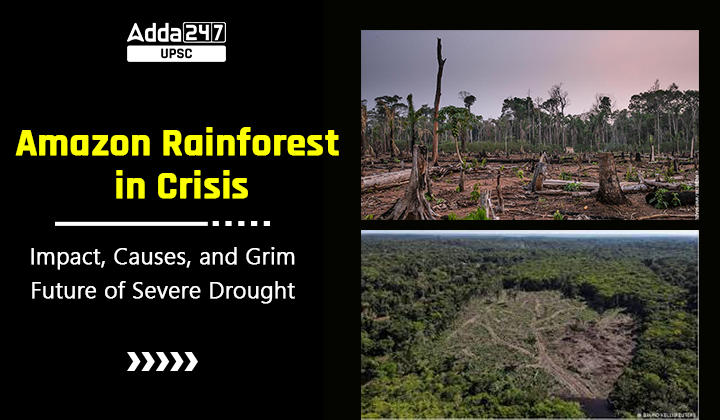Table of Contents
The Amazon rainforest, often referred to as the “planet’s lungs,” is currently grappling with a severe drought that has disrupted the lives of tens of thousands of Indigenous people. This crisis, which is characterized by dried-up rivers, dead fish, and a lack of essential resources, has far-reaching effects on both local communities and the environment at large. In this article, we will explore the causes and impacts of the ongoing drought, shedding light on the complex interplay of natural phenomena and human activities.
Amazon Rainforest Crisis Unprecedented Drought
Record low water levels
The Rio Negro, one of the world’s largest rivers, has hit a historic low level, reaching 13.59 meters near the city of Manaus. The governor of Amazonas, Wilson Lima, described it as the “worst drought in history,” emphasizing the severity of the situation.
Devastating Consequences for Indigenous Communities
The drought has left Indigenous communities stranded, with vital rivers for travel drying up. Lack of access to water, food, and medicine has become a pressing concern, endangering the well-being of tens of thousands of people. Dead fish and river dolphins contaminating water supplies make the situation worse by forcing locals to use polluted water for necessary tasks.
Environmental Ramifications: Wildfires and Air Quality
Extremely dry conditions have made the rainforest susceptible to wildfires. The Amazon state has witnessed an alarming number of blazes, reaching 2,700 in a single month, contributing to the highest October record in 25 years. The resulting smoke has plunged air quality in Manaus to hazardous levels, affecting vulnerable populations, particularly children and the elderly.
El Nino and High Sea Surface Temperatures
The Role of El Nino
Although Amazonian droughts are not unusual, two different natural occurrences are making the current situation worse. El Nino, characterized by abnormal warming of surface waters in the equatorial Pacific Ocean, plays a pivotal role. This weather pattern intensifies heat globally, impacting the Amazon by hindering cloud formation and reducing rainfall.
High water temperatures in the Atlantic
Another contributing factor is the unusually high water temperatures in the northern tropical Atlantic Ocean. Elevated ocean temperatures lead to heated air rising into the atmosphere, reaching the Amazon rainforest. This warm air disrupts cloud formation, causing a significant drop in rainfall levels. The convergence of these two phenomena results in a more intense and widespread drought across the Amazon biome.
Climate Change and Long-Term Impact
Increasing Frequency of Droughts
Historical droughts in the Amazon, including the 2021 dry spell, are harbingers of a more ominous future. Studies suggest that rising global temperatures will lead to longer and more frequent droughts. A 2022 study published in the Proceedings of the National Academy of Sciences predicts that, if current fossil fuel consumption persists, Amazon will experience major droughts nine out of every ten years by 2060.
Tipping Points and Transformation
Another study published in the journal Nature underscores the vulnerability of the Amazon. The rainforest has become slower at recovering from prolonged droughts over the past two decades, edging closer to a tipping point. Beyond this critical threshold, the lush green forest could transform into a drier, open savanna, releasing vast amounts of stored carbon and exacerbating global warming.
Curbing Deforestation and Emissions
Deforestation as a Contributing Factor: Over the last five decades, a significant portion of the Amazon—between 17 and 20 percent—has been destroyed. Human activities, particularly deforestation, have played a pivotal role in weakening the resilience of the rainforest. Urgent action is needed to curb deforestation and protect the remaining pristine areas.
Greenhouse Gas Emissions: A Global Responsibility
Responsibility extends beyond the borders of the Amazon. Greenhouse gas emissions, driven by the burning of fossil fuels, contribute to global climate change. Addressing this crisis requires a concerted global effort to reduce emissions and transition towards sustainable practices.
Reforestation as a Mitigation Strategy
Experts emphasize the urgent need for reforestation to counteract the damage done to the Amazon. Restoration initiatives can improve the rainforest’s ability to withstand the effects of climate change and stop the irreversible transformation that scientific studies have predicted.
Conclusion
The current severe drought in the Amazon rainforest serves as a stark reminder of the interconnectedness of environmental systems and the delicate balance that sustains our planet. The consequences of this crisis extend beyond the immediate hardships faced by Indigenous communities; they reverberate globally, affecting climate patterns and exacerbating the ongoing climate crisis. Urgent action is needed to address the root causes, mitigate the impacts, and safeguard the Amazon, a vital ecosystem that plays a crucial role in maintaining the health of our planet. The choices we make today will determine the fate of the Amazon and, by extension, the future of our planet.



 TSPSC Group 1 Question Paper 2024, Downl...
TSPSC Group 1 Question Paper 2024, Downl...
 TSPSC Group 1 Answer key 2024 Out, Downl...
TSPSC Group 1 Answer key 2024 Out, Downl...
 UPSC Prelims 2024 Question Paper, Downlo...
UPSC Prelims 2024 Question Paper, Downlo...




